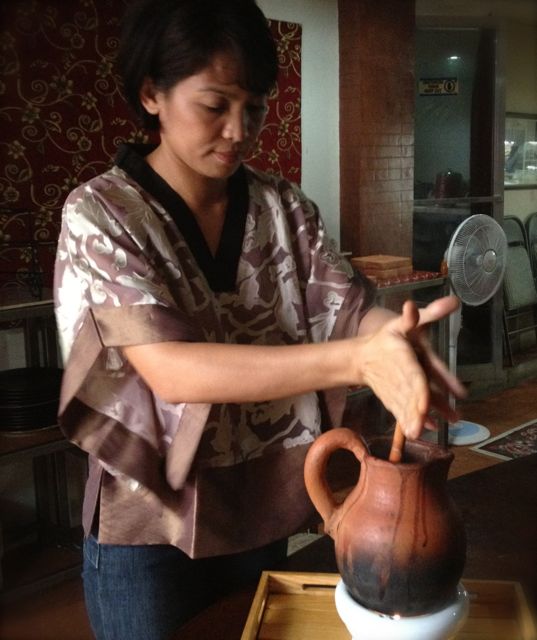SUMMARY
This is AI generated summarization, which may have errors. For context, always refer to the full article.

MANILA, Philippines – From its humble beginnings in Raquel’s kitchen in Cebu, Ralfe Artisan Chocolates (Ralfe Gourmet) has come a long way. It is now making a buzz not just for its pure, delectable chocolate products, but also for its distinctly Filipino cacao – in the international community.
Raquel Choa practically grew up with chocolate. Her grandmother taught her how to plant and roast cacao, followed by the process of making tablea – local chocolate made from Filipino cacao beans. Tablea is also known in the Visayas as sikwate, a chocolate drink.
She shares how her grandmother did not only give her tablea right away for a drink – she was taught how to prepare one. So by the early age of 7, Raquel was already making them on her own.

Some would readily think that making a tablea drink only meant placing tablea chocolate in a clay pot, adding water, and whisking it with a batirol to create froth. Raquel believes that there is more to chocolate than that.
When asked what makes her creations stand out, Raquel says it’s because their chocolate is given that extra ingredient. “We put heart into the chocolate. There’s a passion [put] into it,” she says. We give love in our work.”
That love for tablea eventually turned into a small business. Supplying tablea as an ingredient to some hotels and restaurants was Raquel’s first venture. But after a while, she felt she needed to be making more than just the usual tablea and sikwate. An admittedly self-proclaimed chef, Raquel integrated her cooking skills into their business which brought about the chocolate-making project.
“I couldn’t just keep on making tablea. If it’s just tablea, they will only be ingredients to what chefs in hotels and restaurants are making. We had to evolve. So I decided to make artisan chocolate,” she said.
People in Cebu started to notice her carefully crafted bonne bouche that they eventually attracted more attention – from the right people.
Reintroducing Filipino chocolate to the world
Raquel was given a chance to showcase her chocolates to diplomats in Manila at an event organized by Ambassador Jose Maria Carino. He believes that Raquel’s products have a place in the world’s evolving chocolate market – as a good alternative to Belgian and Swiss favorites due to its distinct Asian flavor.

The woman from Cebu who started making her delicacies in her own, small kitchen was immediately asked for about 1.5 tons of her chocolate to be exported to China – and more orders are coming in. Prior to the event, Raquel was already exporting tablea to gourmet stores in Vancouver. Talks are also ongoing to bring artisan Filipino chocolated to Singapore and Germany.
Foreign Affairs Undersecretary Rafael Seguis, who was at the event, made a speech about how Raquel’s business is one of the things that can help in restoring economic activity in the Visayas – a region recently ravaged by earthquakes and a super typhoon.
Raquel’s cacao farmers come from both Cebu and Bohol. Some of them were affected by the natural disasters. However, the business continues to operate to generate livelihood and raise the quality of life in their community.
Cacao plants, which first made it to Philippine shores in 1670 though a Spanish friar, is currently one of the country’s key crops. The Philippines produces 10,000 metric tons of cacao per year and exports about US$6 million worth of it to the international community. However, the Philippines imports $100-million worth of the same product from other cocoa producers. Why do we do this when we already have plenty of it here?
The Department of Foreign Affairs (DFA) says this is because the Philippines exports raw cacao, while it imports fermented cacao beans which give chocolate bars and other products the taste and texture needed to produce the sweet type of chocolate people get in stores.
Elevating tablea
Seeing the potential of cacao and chocolate in the export market, the national government has endorsed a target to increase cacao crop to 100,000 metric tons per year by the year 2020. Euromonitor International forecasted that the Philippine chocolate market is set to grow 13% or $306.3 million dollars in just 4 years.
Raquel’s initiative to elevate the industry by not being content with just producing raw cacao and tablea as ingredients can certainly open doors for the Philippines. If the country is also processing raw cacao for chocolate, chances are, the import-export ratio of cacao may become even.
Raquel says so far, her chocolates have been well received by the international community. Though hand-rolled truffles are a hit to her foreign clients, she says that her chocolate with chili also piques their curiosity. “Foreign customers are sometimes surprised that it tastes good,” Raquel adds, talking about her out-of-the-ordinary creation.
The Filipinos’ long tradition of cacao has come of age and it’s no wonder that it will soon make a name for itself as it proves to the international community that Filipino chocolate is indeed world-class. – Rappler.com
Add a comment
How does this make you feel?
There are no comments yet. Add your comment to start the conversation.